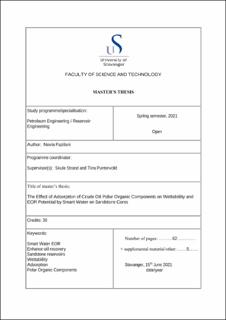| dc.description.abstract | Reservoir wettability is widely acknowledged as one of the most influential parameters in oil recovery processes. The complexity of the underlying crude oil brine rock (CoBR) interactions at the interface boundaries acting within the pores determines the process of establishing and altering wettability. The wettability condition of crude oil is primarily determined by the adsorption or precipitation of the polar organic components (POC). In this study, a series of dynamic adsorption tests were performed to investigate the surface reactivity of acidic and basic POC towards silicate mineral surfaces. The tests were performed by flooding modified crude oil containing low asphaltene content (<1 wt%) with predetermined amounts of acidic and basic POC (~0.2 mg KOH/g) through outcrop and reservoir core samples. Base number (BN) and acid number (AN) of effluent oil samples were compared to the given initial BN and AN of the crude oil to determine adsorption of crude oil components. Because of the presence of negatively charged silica minerals, sandstone minerals showed a preference for organic basic adsorption compared to positively charged acidic components. In addition, oil recovery by spontaneous imbibition test were carried out to determine the effect of POC adsorption on the capillary forces and wettability. The main points to compare were the rate of imbibition and the oil recovery.
Another research point of this study was to investigate if ionic modified Smart water brine can improve capillary forces and mobilize extra oil to recover. Smart Water is made by adjusting the ionic composition of the injected brine. The ionic composition of the injected brine can be modified in such a way that can disrupt the established chemical equilibrium of the reservoir, thus altering the wetting conditions. The adsorbed POC shifts the wettability to a less water-wet condition. By applying Smart Water, desorption of the POC occurs and shifts the wettability to a more water-wet condition. This is the process of wettability alteration and it can be reversible. Parameters such as pH, temperature, pressure, and salinity affect the adsorption/desorption process. Smart Water affects parameters related to fluid flow such as capillary forces as well as the relative permeabilities of oil and water. The increase in capillary forces due to the injection of Smart Water can allows better water imbibition into the smaller pores, resulting in improved sweep efficiency and EOR effect. Both the outcrop and reservoir cores showed improvement in oil recovery in spontaneous imbibition tests (SI) when formation water (FW) was replaced by Smart Water.
The initial wetting condition of the reservoir rock must be of a mixed wettability and not completely water-wet in order to observe wettability alteration by Smart Water EOR. A thorough understanding of the initial wettability is required for the successful implementation of Smart Water EOR. To create a mixed wettability condition, the charged POC in crude oil must adsorb or precipitate on the initially water-wet mineral surfaces that contains active adsorption areas. The results show that before crude oil flooding the core sample was found to be in a water-wet condition. The adsorption of the predominant basic oil components slightly reduced the water-wetness of the core samples. | |
